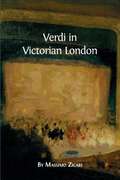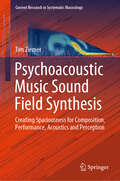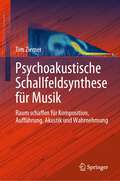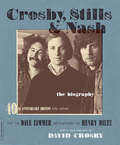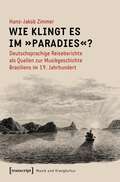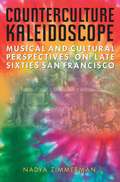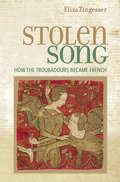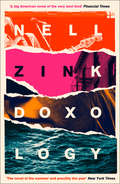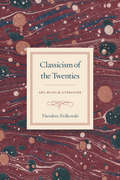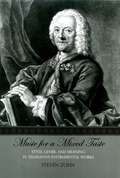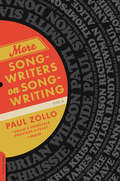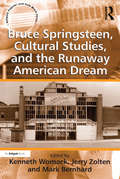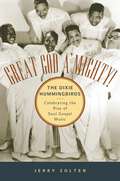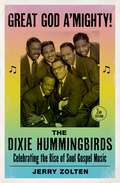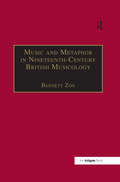- Table View
- List View
Verdi in Victorian London
by Massimo ZicariNow a byword for beauty, Verdi’s operas were far from universally acclaimed when they reached London in the second half of the nineteenth century. Why did some critics react so harshly? Who were they and what biases and prejudices animated them? When did their antagonistic attitude change? And why did opera managers continue to produce Verdi’s operas, in spite of their alleged worthlessness? Massimo Zicari’s Verdi in Victorian London reconstructs the reception of Verdi’s operas in London from 1844, when a first critical account was published in the pages of The Athenaeum, to 1901, when Verdi’s death received extensive tribute in The Musical Times. In the 1840s, certain London journalists were positively hostile towards the most talked-about representative of Italian opera, only to change their tune in the years to come. The supercilious critic of The Athenaeum, Henry Fothergill Chorley, declared that Verdi’s melodies were worn, hackneyed and meaningless, his harmonies and progressions crude, his orchestration noisy. The scribes of The Times, The Musical World, The Illustrated London News, and The Musical Times all contributed to the critical hubbub. Yet by the 1850s, Victorian critics, however grudging, could neither deny nor ignore the popularity of Verdi’s operas. Over the final three decades of the nineteenth century, moreover, London’s musical milieu underwent changes of great magnitude, shifting the manner in which Verdi was conceptualized and making room for the powerful influence of Wagner. Nostalgic commentators began to lament the sad state of the Land of Song, referring to the now departed "palmy days of Italian opera." Zicari charts this entire cultural constellation. Verdi in Victorian London is required reading for both academics and opera aficionados. Music specialists will value a historical reconstruction that stems from a large body of first-hand source material, while Verdi lovers and Italian opera addicts will enjoy vivid analysis free from technical jargon. For students, scholars and plain readers alike, this book is an illuminating addition to the study of music reception.
Verdi in Victorian London
by Massimo ZicariNow a byword for beauty, Verdi’s operas were far from universally acclaimed when they reached London in the second half of the nineteenth century. Why did some critics react so harshly? Who were they and what biases and prejudices animated them? When did their antagonistic attitude change? And why did opera managers continue to produce Verdi’s operas, in spite of their alleged worthlessness? Massimo Zicari’s Verdi in Victorian London reconstructs the reception of Verdi’s operas in London from 1844, when a first critical account was published in the pages of The Athenaeum, to 1901, when Verdi’s death received extensive tribute in The Musical Times. In the 1840s, certain London journalists were positively hostile towards the most talked-about representative of Italian opera, only to change their tune in the years to come. The supercilious critic of The Athenaeum, Henry Fothergill Chorley, declared that Verdi’s melodies were worn, hackneyed and meaningless, his harmonies and progressions crude, his orchestration noisy. The scribes of The Times, The Musical World, The Illustrated London News, and The Musical Times all contributed to the critical hubbub. Yet by the 1850s, Victorian critics, however grudging, could neither deny nor ignore the popularity of Verdi’s operas. Over the final three decades of the nineteenth century, moreover, London’s musical milieu underwent changes of great magnitude, shifting the manner in which Verdi was conceptualized and making room for the powerful influence of Wagner. Nostalgic commentators began to lament the sad state of the Land of Song, referring to the now departed "palmy days of Italian opera." Zicari charts this entire cultural constellation. Verdi in Victorian London is required reading for both academics and opera aficionados. Music specialists will value a historical reconstruction that stems from a large body of first-hand source material, while Verdi lovers and Italian opera addicts will enjoy vivid analysis free from technical jargon. For students, scholars and plain readers alike, this book is an illuminating addition to the study of music reception.
Verdi in Victorian London (PDF)
by Massimo ZicariNow a byword for beauty, Verdi's operas were far from universally acclaimed when they reached London in the second half of the nineteenth century. Why did some critics react so harshly? Who were they and what biases and prejudices animated them? When did their antagonistic attitude change? And why did opera managers continue to produce Verdi's operas, in spite of their alleged worthlessness? Massimo Zicari's Verdi in Victorian London reconstructs the reception of Verdi's operas in London from 1844, when a first critical account was published in the pages of The Athenaeum, to 1901, when Verdi's death received extensive tribute in The Musical Times. In the 1840s, certain London journalists were positively hostile towards the most talked-about representative of Italian opera, only to change their tune in the years to come. The supercilious critic of The Athenaeum, Henry Fothergill Chorley, declared that Verdi's melodies were worn, hackneyed and meaningless, his harmonies and progressions crude, his orchestration noisy. The scribes of The Times, The Musical World, The Illustrated London News, and The Musical Times all contributed to the critical hubbub. Yet by the 1850s, Victorian critics, however grudging, could neither deny nor ignore the popularity of Verdi's operas. Over the final three decades of the nineteenth century, moreover, London's musical milieu underwent changes of great magnitude, shifting the manner in which Verdi was conceptualized and making room for the powerful influence of Wagner. Nostalgic commentators began to lament the sad state of the Land of Song, referring to the now departed "palmy days of Italian opera." Zicari charts this entire cultural constellation. Verdi in Victorian London is required reading for both academics and opera aficionados. Music specialists will value a historical reconstruction that stems from a large body of first-hand source material, while Verdi lovers and Italian opera addicts will enjoy vivid analysis free from technical jargon. For students, scholars and plain readers alike, this book is an illuminating addition to the study of music reception.
The Voice of the Century: The Culture of Italian Bel Canto in Luisa Tetrazzini’s Recorded Interpretations
by Massimo ZicariThe fields of performance studies, empirical musicology, and the musicology of recordings have seen a tremendous development in recent years, shedding new light on the recent history of our performing tradition and conveying essential information to music practitioners, critics and audiences. This innovative work considers the notion of bel canto and the manner in which this vibrant tradition lives in the records of Luisa Tetrazzini (1871-1940), one of the most celebrated sopranos ever. Tetrazzini, whose discographic career includes about 120 recordings, belongs to that generation of inspirational performers who heralded the dawn of a new era of music appreciation, alongside such iconic figures as Enrico Caruso, Adelina Patti and Nellie Melba. Drawing on a vast body of scholarship and a number of contemporary reviews, Massimo Zicari establishes Tetrazzini’s role in the Italian operatic tradition and its much disputed set of performing conventions. His transcriptions of her recorded interpretations from Rossini, Donizetti, Bellini and Verdi will prove invaluable to singers and conductors interested in a tradition that goes back to legendary figures such as Jenny Lind and Maria Malibran. The author also discusses her voice quality and technique, tempo flexibility, her use of vibrato and portamento—features of musical performance that question several widely-held, normative views about aesthetics and interpretative tradition. The volume includes eighty-eight musical examples and its closing section consists of the vocal scores of thirteen operatic arias. The musical material (both examples and transcriptions) is entirely original. This unique approach seeks to combine an academic perspective with the making of the music, in the hope that the plea for originality may be enhanced by models from the past.
Psychoacoustic Music Sound Field Synthesis: Creating Spaciousness for Composition, Performance, Acoustics and Perception (Current Research in Systematic Musicology #7)
by Tim ZiemerThis book provides a broad overview of spaciousness in music theory, from mixing and performance practice, to room acoustics, psychoacoustics and audio engineering, and presents the derivation, implementation and experimental validation of a novel type of spatial audio system. Discussing the physics of musical instruments and the nature of auditory perception, the book enables readers to precisely localize synthesized musical instruments while experiencing their timbral variance and spatial breadth.Offering interdisciplinary insights for novice music enthusiasts and experts in the field of spatial audio, this book is suitable for anyone interested in the study of music and musicology and the application of spatial audio mixing, or those seeking an overview of the state of the art in applied psychoacoustics for spatial audio.
Psychoakustische Schallfeldsynthese für Musik: Raum schaffen für Komposition, Aufführung, Akustik und Wahrnehmung
by Tim ZiemerDieses Buch bietet einen umfassenden Überblick über die Räumlichkeit in der Musiktheorie, von der Abmischung und Aufführungspraxis bis hin zur Raumakustik, Psychoakustik und Tontechnik, und stellt die Ableitung, Implementierung und experimentelle Validierung eines neuartigen räumlichen Audiosystems vor. Durch die Erörterung der Physik von Musikinstrumenten und der Natur der auditiven Wahrnehmung ermöglicht das Buch den Lesern, synthetische Musikinstrumente präzise zu lokalisieren und gleichzeitig ihre klangliche Varianz und räumliche Weite zu erleben. Dieses Buch bietet interdisziplinäre Einblicke für Musikneulinge und Experten auf dem Gebiet der räumlichen Audiotechnik. Es eignet sich für alle, die sich für das Studium von Musik und Musikwissenschaft und die Anwendung von räumlichen Audiomischungen interessieren oder einen Überblick über den Stand der Technik in der angewandten Psychoakustik für räumliches Audio suchen.
Crosby, Stills & Nash: The Biography
by Dave ZimmerCrosby, Stills & Nash created some of the most indelible songs and beautiful harmonies of the late 1960s and early 1970s: "Suite: Judy Blue Eyes," "Woodstock," "Teach Your Children."This copiously illustrated account of the trio's personal and musical history tells the story behind the songs. Longtime CSN chronicler Dave Zimmer, with the full cooperation of the band, traces all of the performers from their musical roots to their first song together in L.A.'s storied Laurel Canyon; from their addition of Neil Young to Woodstock; and through their stormy years of creative conflicts, reunions, and reconciliations.This edition celebrates the trio's 40th anniversary and includes over 300 photos.
Crosby, Stills & Nash: The Biography
by Dave ZimmerCrosby, Stills & Nash created some of the most indelible songs and beautiful harmonies of the late 1960s and early 1970s: "Suite: Judy Blue Eyes," "Woodstock," "Teach Your Children."This copiously illustrated account of the trio's personal and musical history tells the story behind the songs. Longtime CSN chronicler Dave Zimmer, with the full cooperation of the band, traces all of the performers from their musical roots to their first song together in L.A.'s storied Laurel Canyon; from their addition of Neil Young to Woodstock; and through their stormy years of creative conflicts, reunions, and reconciliations.This edition celebrates the trio's 40th anniversary and includes over 300 photos.
Wie klingt es im »Paradies«?: Deutschsprachige Reiseberichte als Quellen zur Musikgeschichte Brasiliens im 19. Jahrhundert (Musik und Klangkultur #38)
by Hans-Jakob ZimmerReiseberichten eilt in der Musikforschung ein ambivalenter Ruf voraus: Mitunter kategorisch abgelehnt als ernst zu nehmende Quellen, bergen sie gleichwohl häufig einzigartige Informationen zur musikalischen Frühgeschichte von Ethnien und Ländern. Darüber hinaus erweisen sie sich als wertvolle mentalitätsgeschichtliche Dokumente ihrer Autor_innen. Hans-Jakob Zimmer unternimmt die bislang umfangreichste Auswertung deutschsprachiger Reiseberichte im Hinblick auf das Musikleben des Landes Brasilien, welches nach der Umsiedlung des portugiesischen Königshofs nach Rio de Janeiro im Jahr 1808 zu einem Sehnsuchtsort für Naturforscher, Reisende und Auswanderer avancierte.
Counterculture Kaleidoscope: Musical and Cultural Perspectives on Late Sixties San Francisco
by Nadya ZimmermanForty years after the fact, 1960s counterculture---personified by hippies, protest, and the Summer of Love---basks in a nostalgic glow in the popular imagination as a turning point in modern American history and the end of the age of innocence. Yet, while the era has come to be synonymous with rebellion and opposition, its truth is much more complex. In a bold reconsideration of the late sixties San Francisco counterculture movement, Counterculture Kaleidoscope takes a close look at the cultural and musical practices of that era. Addressing the conventional wisdom that the movement was grounded in rebellion and opposition, the book exposes two myths: first, that the counterculture was an organized social and political movement of progressives with a shared agenda who opposed the mainstream (dubbed "hippies"); and second, that the counterculture was an innocent entity hijacked by commercialism and transformed over time into a vehicle of so-called "hip consumerism." Seeking an alternative to the now common narrative, Nadya Zimmerman examines primary source material including music, artwork, popular literature, personal narratives, and firsthand historical accounts. She reveals that the San Francisco counterculture wasn't interested in commitments to causes and made no association with divisive issues---that it embraced everything in general and nothing in particular. "Astute and accessible, Counterculture Kaleidoscope provides thought-provoking insights into the historical, cultural and social context of the San Francisco counter-culture and its music scene, including discussions of Vietnam and student protest, the Haight-Ashbury Diggers, the Grateful Dead, Led Zeppelin, Altamont, and Charlie Manson. A must for students and scholars of socio-musical activity and for all of us to whom music matters." ---Sheila Whiteley, author of The Space Between the Notes: Rock and the Counter-Culture and Too Much Too Young: Popular Music, Age and Gender "The hippie counterculture has never garnered the scholarly attention accorded the new left and the black freedom struggle. Overviews of the period ritualistically mention it as part and parcel of that apparently incandescent era---the Sixties---but rarely capture its distinctiveness. Counterculture Kaleidoscope is a timely and provocative intervention in Sixties scholarship that significantly deepens our understanding of this important but understudied phenomenon." —Alice Echols, Associate Professor, University of Southern California, and author of Scars of Sweet Paradise: The Life and Times of Janis Joplin
Stolen Song: How the Troubadours Became French
by Eliza ZingesserStolen Song documents the act of cultural appropriation that created a founding moment for French literary history: the rescripting and domestication of troubadour song, a prestige corpus in the European sphere, as French. This book also documents the simultaneous creation of an alternative point of origin for French literary history—a body of faux-archaic Occitanizing songs.Most scholars would find the claim that troubadour poetry is the origin of French literature uncomplicated and uncontroversial. However, Stolen Song shows that the "Frenchness" of this tradition was invented, constructed, and confected by francophone medieval poets and compilers keen to devise their own literary history.Stolen Song makes a major contribution to medieval studies both by exposing this act of cultural appropriation as the origin of the French canon and by elaborating a new approach to questions of political and cultural identity. Eliza Zingesser shows that these questions, usually addressed on the level of narrative and theme, can also be fruitfully approached through formal, linguistic, and manuscript-oriented tools.
Doxology: A Novel
by Nell ZinkTwo generations of an American family come of age – one before 9/11, one after – in this moving and original novel from the “intellectually restless, uniquely funny” (New York Times Book Review) mind of Nell Zink
Classicism of the Twenties: Art, Music, and Literature
by Theodore ZiolkowskiThe triumph of avant-gardes in the 1920s tends to dominate our discussions of the music, art, and literature of the period. But the broader current of modernism encompassed many movements, and one of the most distinct and influential was a turn to classicism. In Classicism of the Twenties, Theodore Ziolkowski offers a compelling account of that movement. Giving equal attention to music, art, and literature, and focusing in particular on the works of Stravinsky, Picasso, and T. S. Eliot, he shows how the turn to classicism manifested itself. In reaction both to the excesses of neoromanticism and early modernism and to the horrors of World War I—and with respectful detachment—artists, writers, and composers adapted themes and forms from the past and tried to imbue their own works with the values of simplicity and order that epitomized earlier classicisms. By identifying elements common to all three arts, and carefully situating classicism within the broader sweep of modernist movements, Ziolkowski presents a refreshingly original view of the cultural life of the 1920s.
Classicism of the Twenties: Art, Music, and Literature
by Theodore ZiolkowskiThe triumph of avant-gardes in the 1920s tends to dominate our discussions of the music, art, and literature of the period. But the broader current of modernism encompassed many movements, and one of the most distinct and influential was a turn to classicism. In Classicism of the Twenties, Theodore Ziolkowski offers a compelling account of that movement. Giving equal attention to music, art, and literature, and focusing in particular on the works of Stravinsky, Picasso, and T. S. Eliot, he shows how the turn to classicism manifested itself. In reaction both to the excesses of neoromanticism and early modernism and to the horrors of World War I—and with respectful detachment—artists, writers, and composers adapted themes and forms from the past and tried to imbue their own works with the values of simplicity and order that epitomized earlier classicisms. By identifying elements common to all three arts, and carefully situating classicism within the broader sweep of modernist movements, Ziolkowski presents a refreshingly original view of the cultural life of the 1920s.
Classicism of the Twenties: Art, Music, and Literature
by Theodore ZiolkowskiThe triumph of avant-gardes in the 1920s tends to dominate our discussions of the music, art, and literature of the period. But the broader current of modernism encompassed many movements, and one of the most distinct and influential was a turn to classicism. In Classicism of the Twenties, Theodore Ziolkowski offers a compelling account of that movement. Giving equal attention to music, art, and literature, and focusing in particular on the works of Stravinsky, Picasso, and T. S. Eliot, he shows how the turn to classicism manifested itself. In reaction both to the excesses of neoromanticism and early modernism and to the horrors of World War I—and with respectful detachment—artists, writers, and composers adapted themes and forms from the past and tried to imbue their own works with the values of simplicity and order that epitomized earlier classicisms. By identifying elements common to all three arts, and carefully situating classicism within the broader sweep of modernist movements, Ziolkowski presents a refreshingly original view of the cultural life of the 1920s.
Classicism of the Twenties: Art, Music, and Literature
by Theodore ZiolkowskiThe triumph of avant-gardes in the 1920s tends to dominate our discussions of the music, art, and literature of the period. But the broader current of modernism encompassed many movements, and one of the most distinct and influential was a turn to classicism. In Classicism of the Twenties, Theodore Ziolkowski offers a compelling account of that movement. Giving equal attention to music, art, and literature, and focusing in particular on the works of Stravinsky, Picasso, and T. S. Eliot, he shows how the turn to classicism manifested itself. In reaction both to the excesses of neoromanticism and early modernism and to the horrors of World War I—and with respectful detachment—artists, writers, and composers adapted themes and forms from the past and tried to imbue their own works with the values of simplicity and order that epitomized earlier classicisms. By identifying elements common to all three arts, and carefully situating classicism within the broader sweep of modernist movements, Ziolkowski presents a refreshingly original view of the cultural life of the 1920s.
Music for a Mixed Taste: Style, Genre, and Meaning in Telemann's Instrumental Works
by Steven ZohnGeorg Philipp Telemann gave us one of the richest legacies of instrumental music from the eighteenth century. Though considered a definitive contribution to the genre during his lifetime, his concertos, sonatas, and suites were then virtually ignored for nearly two centuries following his death. Yet these works are now among the most popular in the baroque repertory. In Music for a Mixed Taste, Steven Zohn considers Telemann's music from stylistic, generic, and cultural perspectives. He investigates the composer's cosmopolitan "mixed taste"--a blending of the French, Italian, English, and Polish national styles-and his imaginative expansion of this concept to embrace mixtures of the old (late baroque) and new (galant) styles. Telemann had an equally remarkable penchant for generic amalgamation, exemplified by his pioneering role in developing hybrid types such as the sonata in concerto style ("Sonate auf Concertenart") and overture-suite with solo instrument ("Concert en ouverture"). Zohn examines the extramusical meanings of Telemann's "characteristic" overture-suites, which bear descriptive texts associating them with literature, medicine, politics, religion, and the natural world, and which acted as vehicles for the composer's keen sense of musical humor. Zohn then explores Telemann's unprecedented self-publishing enterprise at Hamburg, and sheds light on the previously unrecognized borrowing by J.S. Bach from a Telemann concerto. Music for a Mixed Taste further reveals how Telemann's style polonaise generates musical and social meanings through the timeless oppositions of Orient-Occident, urban-rural, and serious-comic.
More Songwriters on Songwriting
by Paul ZolloThe long-awaited sequel to Songwriters on Songwriting, often called "the songwriter's bible," More Songwriters on Songwriting goes to the heart of the creative process with in-depth interviews with many of the world's greatest songwriters. Covering every genre of popular music from folk, rock 'n' roll, Broadway, jazz, pop, and modern rock, this is a remarkable journey through some sixty years of popular songwriting: from Leiber & Stoller's genius rock 'n' roll collaborations and Richard Sherman's Disney songs to Kenny Gamble's Philly Sound; Norman Whitfield's Motown classics; Loretta Lynn's country standards; expansive folk music from Peter, Paul, and Mary; folk-rock from Stephen Stills; confessional gems from James Taylor; poetic excursions form Patti Smith; Beatles magic from Ringo Starr; expansive brilliance from Paul Simon; complex melodic greatness from Brian Wilson; the most untrustworthy narrator alive in Randy Newman; the dark rock theater of both Alice Cooper and Rob Zombie; the sophisticated breadth of Elvis Costello; the legendary jazz of Herbie Hancock; the soulful swagger of of Chrissie Hynde; the funny-poignant beauty of John Prine; the ancient wisdom fused with hip-hop and reggae of Matisyahu; and much more. In all of it is the collective wisdom of those who have written songs for decades, songs that have impacted our culture forever.
Bruce Springsteen, Cultural Studies, and the Runaway American Dream (Ashgate Popular and Folk Music Series)
by Jerry ZoltenThere is little question about the incredible power of Bruce Springsteen's work as a particularly transformative art, as a lyrical and musical fusion that never shies away from sifting through the rubble of human conflict. As Rolling Stone magazine's Parke Puterbaugh observes, Springsteen 'is a peerless songwriter and consummate artist whose every painstakingly crafted album serves as an impassioned and literate pulse taking of a generation's fortunes. He is the foremost live performer in the history of rock and roll, a self-described prisoner of the music he loves, for whom every show is played as if it might be his last.' In recent decades, Puterbaugh adds, 'Springsteen's music developed a conscience that didn't ignore the darkening of the runaway American Dream as the country greedily blundered its way through the 1980s' and into the sociocultural detritus of a new century paralysed by isolation and uncertainty. Bruce Springsteen, Cultural Studies, and the Runaway American Dream reflects the significant critical interest in understanding Springsteen's resounding impact upon the ways in which we think and feel about politics, religion, gender, and the pursuit of the American Dream. By assembling a host of essays that engage in interdisciplinary commentary regarding one of Western culture's most enduring artistic and socially radicalizing phenomena, this book offers a cohesive, intellectual, and often entertaining introduction to the many ways in which Springsteen continues to impact our lives by challenging our minds through his lyrics and music.
Bruce Springsteen, Cultural Studies, and the Runaway American Dream (Ashgate Popular and Folk Music Series)
by Jerry ZoltenThere is little question about the incredible power of Bruce Springsteen's work as a particularly transformative art, as a lyrical and musical fusion that never shies away from sifting through the rubble of human conflict. As Rolling Stone magazine's Parke Puterbaugh observes, Springsteen 'is a peerless songwriter and consummate artist whose every painstakingly crafted album serves as an impassioned and literate pulse taking of a generation's fortunes. He is the foremost live performer in the history of rock and roll, a self-described prisoner of the music he loves, for whom every show is played as if it might be his last.' In recent decades, Puterbaugh adds, 'Springsteen's music developed a conscience that didn't ignore the darkening of the runaway American Dream as the country greedily blundered its way through the 1980s' and into the sociocultural detritus of a new century paralysed by isolation and uncertainty. Bruce Springsteen, Cultural Studies, and the Runaway American Dream reflects the significant critical interest in understanding Springsteen's resounding impact upon the ways in which we think and feel about politics, religion, gender, and the pursuit of the American Dream. By assembling a host of essays that engage in interdisciplinary commentary regarding one of Western culture's most enduring artistic and socially radicalizing phenomena, this book offers a cohesive, intellectual, and often entertaining introduction to the many ways in which Springsteen continues to impact our lives by challenging our minds through his lyrics and music.
Great God A'Mighty! The Dixie Hummingbirds: Celebrating the Rise of Soul Gospel Music
by Jerry ZoltenFrom the Jim Crow world of 1920s Greenville, South Carolina, to Greenwich Village's Café Society in the '40s, to their 1974 Grammy-winning collaboration on "Loves Me Like a Rock," the Dixie Hummingbirds have been one of gospel's most durable and inspiring groups. Now, Jerry Zolten tells the Hummingbirds' fascinating story and with it the story of a changing music industry and a changing nation. When James Davis and his high-school friends starting singing together in a rural South Carolina church they could not have foreseen the road that was about to unfold before them. They began a ten-year jaunt of "wildcatting," traveling from town to town, working local radio stations, schools, and churches, struggling to make a name for themselves. By 1939 the a cappella singers were recording their four-part harmony spirituals on the prestigious Decca label. By 1942 they had moved north to Philadelphia and then New York where, backed by Lester Young's band, they regularly brought the house down at the city's first integrated nightclub, Café Society. From there the group rode a wave of popularity that would propel them to nation-wide tours, major record contracts, collaborations with Stevie Wonder and Paul Simon, and a career still vibrant today as they approach their seventy-fifth anniversary. Drawing generously on interviews with Hank Ballard, Otis Williams, and other artists who worked with the Hummingbirds, as well as with members James Davis, Ira Tucker, Howard Carroll, and many others, The Dixie Hummingbirds brings vividly to life the growth of a gospel group and of gospel music itself.
Great God A'Mighty! The Dixie Hummingbirds: Celebrating the Rise of Soul Gospel Music
by Jerry ZoltenThe venerable Dixie Hummingbirds stand at the top of the black gospel music pantheon as artists who not only significantly shaped that genre but, in the process, also profoundly influenced emerging American pop music genres from Rhythm & Blues and Doo-Wop to Rock 'n' Roll, Soul, and Hip-Hop. Great God A'Mighty! The Dixie Hummingbirds shows how, in a career spanning more than nine decades, they pointed the way from pure a cappella harmony to guitar-driven soul to pop-stardom crossover, collaborating with artists like Stevie Wonder and Paul Simon along the way. Drawing on interviews with founding and quintessential members as well as many of the pop luminaries influenced by the Hummingbirds, author Jerry Zolten tells their story from rising up and out of the segregated South in the twenties and thirties to success on Philadelphia radio and the New York City stage in the forties to grueling tours in the fifties and over the long haul a brilliant recording career that carried well over into the 21st century. The story of the Dixie Hummingbirds is a tale of determined young men who navigated the troubled waters of racial division and the cutthroat business of music on the strength of raw talent, vision, character, and perseverance, and made an indelible name for themselves in American cultural history. This heavily edited 2nd edition features brand new photographs, expanded historical context, and a full new chapter on the Hummigbirds' trajectory up to the 21st century.
Great God A'Mighty! The Dixie Hummingbirds: Celebrating the Rise of Soul Gospel Music
by Jerry ZoltenThe venerable Dixie Hummingbirds stand at the top of the black gospel music pantheon as artists who not only significantly shaped that genre but, in the process, also profoundly influenced emerging American pop music genres from Rhythm & Blues and Doo-Wop to Rock 'n' Roll, Soul, and Hip-Hop. Great God A'Mighty! The Dixie Hummingbirds shows how, in a career spanning more than nine decades, they pointed the way from pure a cappella harmony to guitar-driven soul to pop-stardom crossover, collaborating with artists like Stevie Wonder and Paul Simon along the way. Drawing on interviews with founding and quintessential members as well as many of the pop luminaries influenced by the Hummingbirds, author Jerry Zolten tells their story from rising up and out of the segregated South in the twenties and thirties to success on Philadelphia radio and the New York City stage in the forties to grueling tours in the fifties and over the long haul a brilliant recording career that carried well over into the 21st century. The story of the Dixie Hummingbirds is a tale of determined young men who navigated the troubled waters of racial division and the cutthroat business of music on the strength of raw talent, vision, character, and perseverance, and made an indelible name for themselves in American cultural history. This heavily edited 2nd edition features brand new photographs, expanded historical context, and a full new chapter on the Hummigbirds' trajectory up to the 21st century.
Music and Metaphor in Nineteenth-Century British Musicology
by Bennett Zon�In a word, I shall endeavour to show how our music, having been originally a shell-fish, with its restrictive skeleton on the outside and no soul within, has been developed by the inevitable laws of evolution, through natural selection and the survival of the fittest, into something human, even divine, with the strong, logical skeleton of its science inside, the fair flesh of God-given beauty outside, and the whole, like man himself, animated by a celestial, eternal spirit....� W.J. Henderson, The Story of Music (1889) Critical writing about music and music history in nineteenth-century Britain was permeated with metaphor and analogy. Music and Metaphor examines how over-arching theories of music history were affected by reference to various figurative linguistic templates adopted from other disciplines such as art, religion, politics and science. Each section of the book discusses a wide range of musicological writings and their correspondence with the language used to convey contemporary ideas such as the sublime, the ancient and modern debate, and, in particular, the theory of evolution. Bennett Zon reveals that through their application of metaphorical frameworks taken from art, religion and science, these writers and their work shed light on nineteenth-century perceptions of music history and illuminate the ways in which these disciplines affected notions of musical development.

